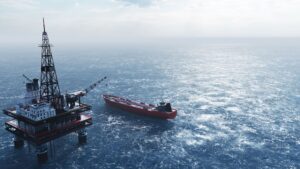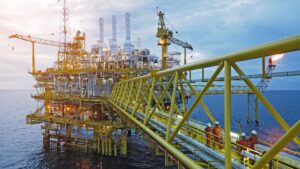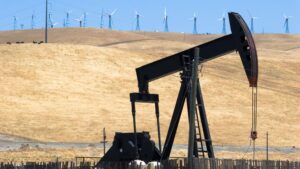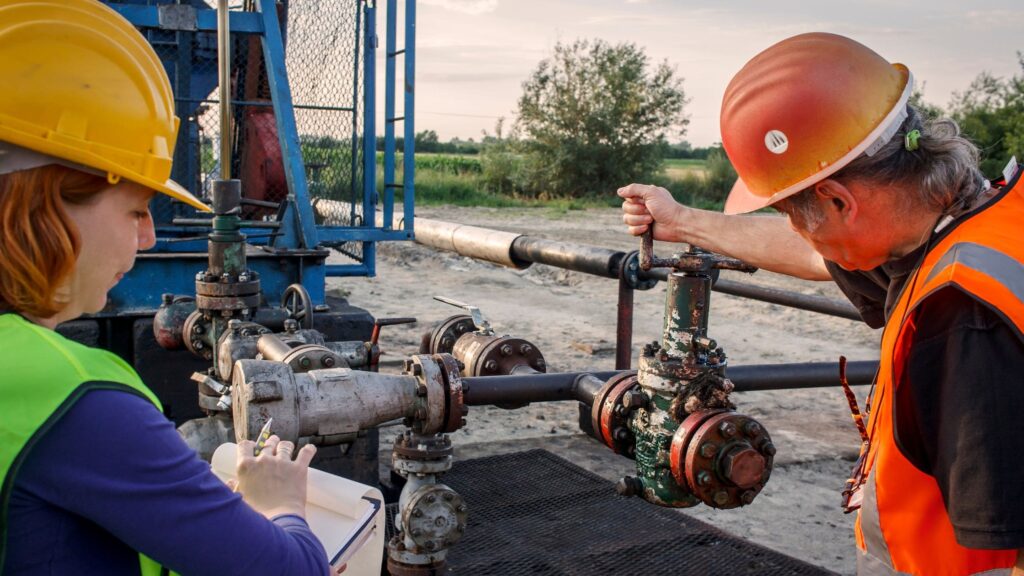So what is oil and gas upstream? It involves companies focusing mainly on the exploration and production stages, identifying a new oil or gas field, and producing crude oil or gas. Operations include creating geological surveys and obtaining land rights, production activities, and the related oilfield services business sector.
Most large companies are integrated companies. They often combine upstream oil and gas operations with midstream and downstream activities in the business sector. These operations take place after the production stage up to the point of sale.
This comprehensive guide will provide important details on upstream oil and gas production.
What is upstream oil and gas production?
The upstream sector of oil and gas production includes all mineral exploration operations, creating geological surveys, obtaining land rights, and production activities related to onshore or offshore acreage. Upstream is also known as exploration and production (E&P). It represents the farthest stage from the final consumer in the supply chain of oil and gas. Companies within the segment are interested in finding and extracting these resources from the earth’s surface.
Typically, the upstream sector feeds into the midstream sector (which involves the transportation of crude oil) and downstream (such as refining and distribution) stages.
Companies associated with upstream oil and gas production and operations are involved in identifying deposits, drilling wells, and recovering raw materials such as petroleum crude oil or gas from underground. The upstream oil and gas industry typically needs geophysicists, geologists, service rig operators, and seismologists, among others.
What are the different upstream activities in the oil industry?
The upstream segment of the petroleum industry consists of the following steps, which will be discussed in this section.
Exploration Stage
- This exploration stage involves the processes associated with locating potential sites for oil and gas extraction.
- In the early stages, oil and gas explorers often rely on specific signals, including natural oil seeps. However, today’s technology has brought greater efficiency to the oil and gas exploration process.
- It is not uncommon for geological surveys to use different means, including seismic imaging, to conduct offshore exploration and test subsoil for onshore exploration.
- Different energy companies compete for access to mineral rights granted by the government through a concession agreement. This implies that any oil and gas discovered belong to the producers. Such concession agreements may also cover production sharing, in which the government retains ownership and participation rights.
- Oil and gas exploration is high-risk and costly. The cost of an unsuccessful exploration project can rise as high as $5 million per exploration site. Companies usually recover the cost of exploration when the site is successful, resulting in productive oil and gas extraction.
- How much economically recoverable oil and gas a company can extract with available technology is measured by proven reserves.
- Updates of the estimates for proven reserves are done over the life of a lease, depending on regular reassessments. Technology influences these estimates.
- Available infrastructure and pricing also influence reserve estimates.
Drilling Stage
- A hole is drilled straight down into the earth’s surface. Special drilling mud cools the drill bit and can help to carry the rock cuttings back to the surface while also offering stability to the walls of the borehole. As the hole goes beyond the deepest freshwater aquifer, the drill pipe is removed and replaced with a surface casing.
- Then, cement is pumped down the casing and back up between the casing and the borehole wall, which allows it to set. With this cement, it is possible to generate a bond that can prevent the movement of fluids between the hole and the casing. The cement can create a crucial, impermeable membrane between any freshwater sources and the well bore.
- This stage requires thorough testing to ensure that the bond is impervious before resource extraction can occur.
- Additional casing sections may be required based on the well’s depth and geology of the area. These are cemented in place to prevent fluid from moving between the groundwater sources and the layers.
- Drilling for hydrocarbons in a shale formation is different, thanks to the necessity for drilling horizontally. The kick-off point is the correct depth where vertical drilling stops and the well bore starts curving to become horizontal.
- The upside of horizontal drilling is that drilling various laterals is possible from only one point on the surface, which reduces the impact and scale of activity above the ground.
- The drill pipe is removed after reaching the target distance, and more steel casting is inserted through the length of the well bore.
- The drilling rig is removed after finishing, and the next step involves completing the well.
Onshore Drilling
- This type of drilling often takes place at the seabed.
- There is a significant number of such drilling sites in the United States.
- Often, coastal communities benefit from their presence.
- Onshore drilling can occur in two categories: trailer-mounted rigs and conventional rigs.
Offshore Drilling
- Offshore drilling involves drilling holes in the ocean seabed of the continental shelf.
- It also applies to drilling in lakes and inland seas.
- Offshore oil wells can last for as long as 15 to 20 years.
Some popular equipment for offshore drilling includes:
- Fixed Platform
- Sea Star
- Compliant Towers
- Floating Production System
- Tension Leg Platform
- Spar Platform
On the other hand, onshore drilling equipment includes:
- Shale Shakers
- Mud Pump
- Mud Tank
- Hose
- Drawworks
- Traveling Block
- Derrick
- Swivel
Hydraulic Fracturing (Fracking)
- Hydraulic fracturing is a method that utilizes a high-pressure liquid to extract oil or gas from geologic formations.
- Stimulation fluid is pumped under controlled conditions into deep, underground reservoir formations. The chemicals are required for lubrication, as well as to prevent the formation of bacteria while carrying the sand.
- The stimulation fluid is a mixture of over 90% water and sand, plus a few chemical additives.
- These non-hazardous chemicals often vary in concentration from 0.5% to 5% by volume.
- These chemicals are required to boost the efficiency and performance of hydraulic fracturing.
- Even though fracking has existed since the 1940s, it was only made more economical in the 1990s.
- A pump forces the stimulation fluid at high pressure through the perforations made by a perforating gun.
- Doing so creates fractures in the shale rock containing oil and natural gas.
- The sand in the fractures is left to ensure they remain open when the pump pressure is relieved.
- Trapped oil or natural gas can then flow to the well bore.
Production Stage
- The production of oil and gas is one of the most capital-intensive industries.
- As soon as the process of hydraulic fracturing is complete, oil and gas production can begin.
- The fracturing fluid is recoverable as the oil and gas flow from the well bore.
- During the initial well production, one-quarter to three-quarters of the fluid is recovered and either disposed of in accordance with environmental regulations or recycled for further fracturing purposes.
- Typically, well development can take between 3 to 5 months. Often, some weeks are needed to prepare the site. Then, about 12 weeks are required to drill the well.
- It takes about one to three months to complete activities.
What are some key characteristics of exploration and production companies?
Some essential characteristics of exploration and production companies are discussed in this section.
High Risk – High Return Companies
It is worth noting that investing in the oil and gas industry comes with various significant risks. Oil and gas prices are highly volatile. As volatility increases, the positive and negative swings in prices are significant. The high level of risk implies that investors must embrace risk management techniques. On the other hand, the possible wild increase in price can also offer huge returns. Besides this, there is also the possibility of an oil spill or other accidents during production.
Highly Regulated
Generally, the oil and gas industry operates under strict regulations at multiple levels of government. As the world embraces various ways of improving the environment, monitoring the toxic waste and chemicals often used by E&P companies is essential. Appropriate regulation also promotes energy security and transparency in administering petroleum resources.
Heavily Impacted by Global Politics
Essentially, politics can affect oil and gas in terms of regulation. However, this is not only the way. Usually, a range of industry regulations restricts how and when an oil and gas company can perform an extraction.
There is also a variation in the interpretation of this law from one state to another. Besides this, if oil and gas companies are working on deposits abroad, then political risk can rise.
Generally, most oil and gas companies operate in nations with stable political systems. However, sometimes, companies might be drawn to an abundance of oil and gas at a particular location without regard for the political risks of operating in such countries.
Various political factors influence Exploration and Production companies. For instance, a changing regulatory environment might result from shifting political ideologies.
With this in mind, several issues may arise. The initial deal a company makes might end up different from the reality it has to accept, such as when the government changes its mind.
Technology Intensive
Modern E&P companies use advanced technologies, which can help them optimize drilling and production throughput. The Internet of Things represents technology adopted by E&P companies to optimize equipment, promote production, and monitor remote areas. Due to the size of their operation, advanced technologies are essential to improve efficiency and boost yield.
What are the different types of upstream oil and gas companies?
It is not difficult to understand how important the oil and gas industry is to today’s economy. Upstream companies play crucial roles in the oil and gas industry. Pheasant Energy is an example, an upstream oil and gas company based in Fort Worth, Texas. This company is capable of acquiring and selling mineral rights. Learn more about their services and operations by visiting their official website at https://www.pheasantenergy.com/. With the wide range of upstream oil and gas companies, this section will examine the different types worth studying.
Independents
These companies mainly focus on a single segment of the industry. An independent company is one that does not have over $5 million in retail sales of oil and gas in one year. Also, the company must not refine over 75,000 barrels per day of crude oil on average in a year. An independent oil and gas company is not an integrated entity.
These companies bring a sharp focus to their business activities. However, when the market conditions are unfavorable, the lack of profit balance between upstream and downstream activities could become an issue.
Major Oil Companies – Integrated Oil & Gas Companies (IOCs)
Integrated oil companies operate across the entire petroleum value chain, from exploration and production of oil and gas (upstream) to transport, refining, and marketing (downstream). In other words, they combine upstream operations with downstream operations.
These companies often divide their operations into upstream and downstream categories while promoting efficiency and control. These companies also focus on different means of revenue, as well as diversification. Some of the largest oil and gas companies worldwide are integrated companies.
National Oil Companies (NOCs)
These are oil and gas companies owned by national governments. These companies often play massive roles in the economies of their home country. Besides this, they are also major players in the global oil and gas markets. The importance of National Oil Companies has increased dramatically over the past few years due to their rising dominance over global reserves. National Oil Companies are also known to invest beyond their national borders.
Oilfield Services
Oilfield services are companies that service the oil and gas industry. Some examples are drilling evaluation, completion services, and well construction. However, it is worth stressing that oilfield services are not involved in the production of petroleum themselves. Generally, these companies focus on the repair, maintenance, and manufacturing of pieces of equipment used in the transportation and extraction of oil.
How Does Upstream Production Differ from Midstream & Downstream Operations?
Upstream, midstream, and downstream oil and gas production refer to the location of an oil or gas company in the supply chain. With this in mind, this section will compare upstream production with midstream and downstream operations.
Upstream Production
- Carried out by companies that locate and extract raw materials.
- Regarded as Exploration and Production companies.
- Employees in the upstream segment include geophysicists, geologists, service rig operators, and many more.
- Companies in this sector also focus on various services like feasibility studies, rig operations, machinery rental, extraction of chemical supply, and more.
Midstream Operations
- The Midstream oil and gas sector serves as a link between upstream and downstream.
- Examples are transportation, processing, and storage services.
- Midstream operations are also involved in treating the product, removing water or waste products, compressing it, and getting it ready for different markets downstream.
- Midstream production includes service companies that focus on operating tanker ships, pipelines, or storage facilities.
Downstream Activities
- The downstream oil and gas sector includes companies focusing on operations carried out after crude oil and natural gas production.
- In other words, these processes occur post-production before the point of sale.
- Many of the products that are used by consumers daily come directly from downstream production.
- Companies involved in the downstream process include petroleum product distributors, natural gas distributors, oil refineries, petrochemical plants, and retail outlets.
Conclusion
The oil and gas industry is broad, and various major players contribute to the supply of oil and natural gas. The three main segments include upstream, midstream, and downstream.
In this guide, we have examined upstream oil and natural gas activities, discussing the major types of upstream companies and their characteristics. Furthermore, it is worth stressing that oil and gas prices are affected by various factors, and thanks to their high volatility, it remains a risky investment.
Yet, it can offer high returns as well. For this reason, the best knowledge is essential before dabbling in the business.







